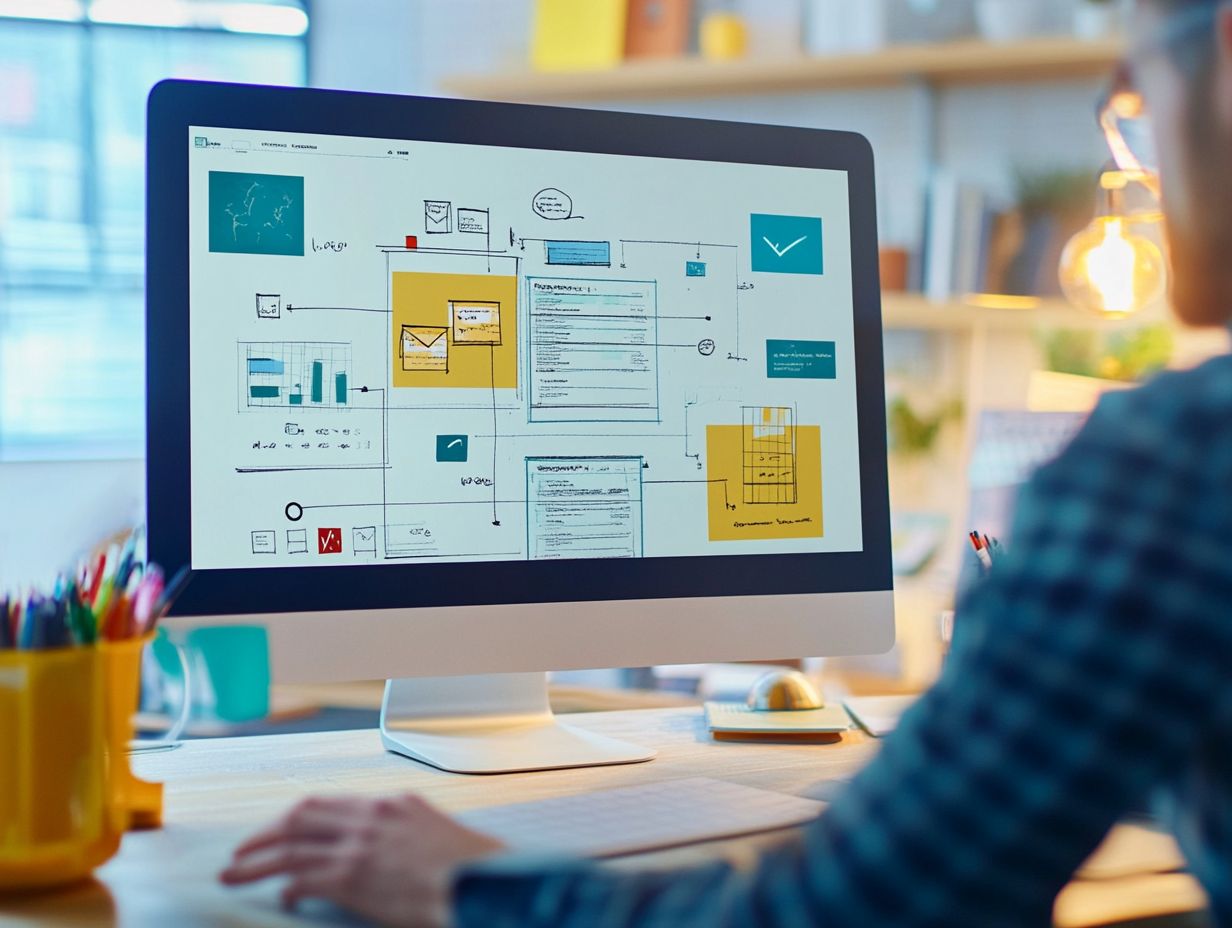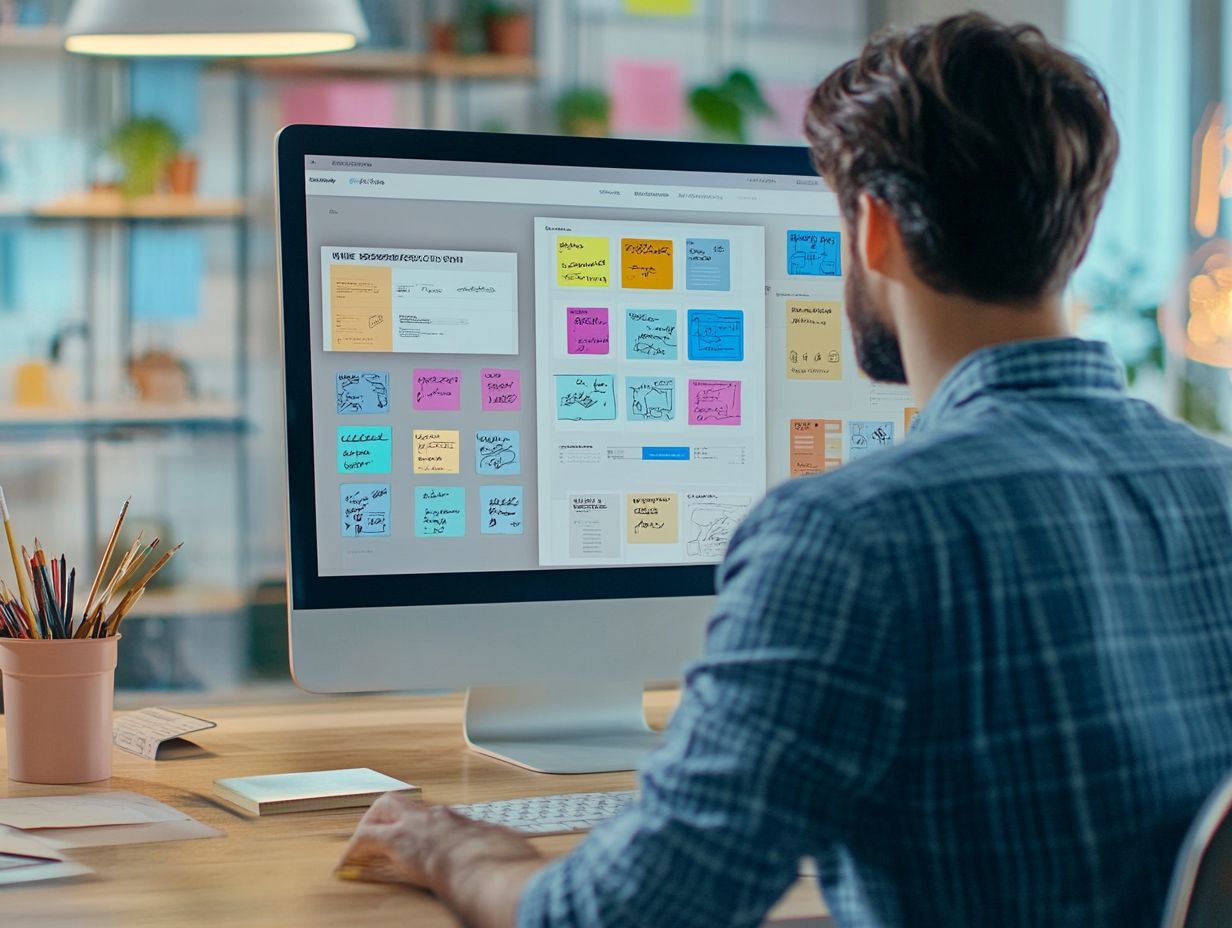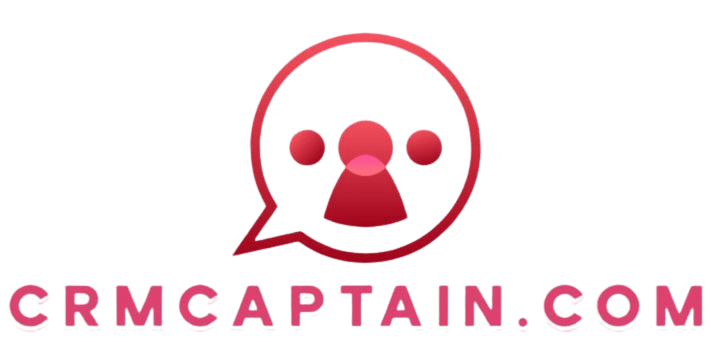How to Optimize CRM User Interface Design
In today s fast-paced business environment, a well-designed Customer Relationship Management (CRM) user interface can truly be a game-changer for you.
It improves usability for a smoother experience while also boosting overall business efficiency. Discover how optimizing your CRM design can transform your business!
This article delves into the significance of optimizing CRM user interface design, emphasizing the key elements that contribute to effective usability, visual appeal, and functionality.
From grasping users’ needs to exploring best practices and resources, you will discover how to elevate your CRM experience, leading to improved engagement and productivity.
Dive in to uncover the secrets of successful CRM design!
Contents
- Key Takeaways:
- Importance of Optimizing CRM User Interface Design
- Key Elements of Effective CRM User Interface Design
- Best Practices for Optimizing CRM User Interface Design
- Tools and Resources for Optimizing CRM User Interface Design
- Preguntas Frecuentes
- Qu es la optimizaci n del dise o de la interfaz de usuario de CRM?
- Por qu es importante optimizar el dise o de la interfaz de usuario de CRM?
- Cu les son algunos elementos clave a considerar al optimizar el dise o de la interfaz de usuario de CRM?
- C mo puedo recopilar comentarios de los usuarios de CRM para informar mi optimizaci n de dise o?
- Existen mejores pr cticas para optimizar el dise o de la interfaz de usuario de CRM?
- Cu les son algunos errores comunes a evitar al optimizar el dise o de la interfaz de usuario de CRM?
Key Takeaways:

- Optimizing CRM design increases efficiency.
- Key elements include usability and visual design.
- Best practices involve understanding users’ needs and continuous testing.
What is CRM User Interface Design?
CRM User Interface Design is all about crafting a visually stunning and highly functional interface for your Customer Relationship Management systems. This strategic process ensures you can manage customer relationships effectively while fulfilling your business needs.
By prioritizing user-friendly design principles, mobile compatibility, and data security, you create a seamless user experience that enhances your workflow.
Incorporating usability testing and visual hierarchy not only aligns with your expectations but also boosts your satisfaction with the system.
The significance of a well-designed CRM User Interface goes far beyond looks; it profoundly influences user engagement and productivity. In today s fast-paced world, user experience design enables you to navigate complex data effortlessly, especially on mobile devices where accessibility is key.
Robust data security measures protect sensitive customer information, building trust and reliability.
Incorporating advanced technologies like AI-driven insights and automation tools enriches functionality and streamlines workflows. By fostering collaboration between designers and developers throughout the software development process, you ensure that innovative technologies are thoughtfully integrated, ultimately delivering a CRM system that is both effective and efficient.
Importance of Optimizing CRM User Interface Design
Optimizing the CRM User Interface Design is essential for elevating user engagement and strengthening customer relationships. Understanding how to optimize your CRM for e-commerce directly influences user adoption rates and aligns seamlessly with the business objectives that drive growth.
A thoughtfully designed CRM system not only enables efficient interaction tracking but also enhances data quality, paving the way for successful communication with both current and potential customers.
By addressing their needs effectively, you position your business for lasting success.
Benefits for Businesses and Users
The benefits of optimizing your CRM User Interface Design are substantial, impacting both your business and users alike.
By enhancing CRM functionality and increasing user satisfaction, you foster emotional connections with customers. A user-friendly design minimizes training costs and streamlines service processes, ultimately contributing to your overall business growth and efficiency in managing customer data.
When you simplify the interface, your employees can navigate the system more intuitively, allowing them to respond to customer inquiries more quickly. For example, when a sales representative can easily access a client s interaction history, they can personalize the conversation, creating a stronger emotional bond.
This not only elevates user satisfaction but also cultivates increased loyalty. Your business will also benefit from reduced training expenses since new employees will require less time to become proficient.
These advantages create a positive environment that enhances customer engagement and drives profitability.
Unlock the potential of your CRM today!
Key Elements of Effective CRM User Interface Design
Key elements of effective CRM user interface design include user experience design, visual consistency, and usability testing. These elements work together to ensure the system aligns with the needs and preferences of its target audience.
By concentrating on workflow configuration and role-based settings, you can create tailored experiences that enhance user navigation and significantly boost overall engagement with the CRM system.
Usability and User Experience

Usability and user experience are crucial in CRM user interface design, directly impacting user satisfaction and the overall effectiveness of the CRM system.
Focusing on usability testing helps you identify areas needing improvement, ensuring a seamless experience that promotes interaction tracking and maximizes the benefits of your CRM technology.
When you prioritize these aspects, you create interfaces that are not just functional but also intuitive. This makes it easier for your teams to navigate efficiently.
Gathering user feedback through methods like A/B testing allows design teams to refine strategies based on real-world usage, leading to a boost in engagement and productivity.
Users are more inclined to embrace a system that meets their needs, enhancing interaction satisfaction and leading to a more effective customer relationship management process.
Visual Design and Branding
Visual design and branding create a visual hierarchy that captures attention and facilitates effective content consumption in CRM user interface design. Consistent design principles enhance user engagement and craft memorable interactions.
In a bustling marketplace, a captivating visual identity sets one CRM apart from the rest, fostering trust and nurturing brand loyalty.
A well-structured layout enables seamless navigation while highlighting crucial information, enriching the overall experience.
For instance, Salesforce s modern aesthetic featuring a muted color palette and clear typography guides users effortlessly through diverse features. Visually appealing dashboards improve data comprehension, making it easier to derive actionable insights.
Ultimately, effective branding strategies that align with your needs deepen your connection to the technology, leading to sustained engagement and satisfaction.
Functionality and Customization
Functionality and customization are vital components of effective CRM user interface design. They allow you to tailor the system to your unique business processes and user navigation preferences.
This adaptability promotes process automation and enhances the experience for both current and potential customers.
By leveraging various customization options within your CRM system, you align the platform closely with your team’s specific needs.
For example, a retail company might set up automated workflows to streamline order processing, dramatically reducing human error and time spent on manual tasks.
In another scenario, a marketing agency utilized CRM functionality to create custom dashboards, providing real-time insights into campaign performance for swift adjustments.
These tailored solutions dramatically boost efficiency, making your team more effective now!
Best Practices for Optimizing CRM User Interface Design
Adopting best practices for optimizing CRM user interface design is crucial for crafting systems that prioritize user-centered design and address end-user needs, including strategies outlined in how to optimize your CRM add-ons.
This process requires meticulous testing and iterative refinement of design elements, guided by user personas and behavioral insights.
By doing so, you can ensure that the final product not only meets but exceeds its intended objectives effectively.
Start optimizing your CRM today for enhanced user satisfaction!
Understanding User Needs and Behaviors
Understanding your users needs and behaviors is essential for crafting a successful CRM User Interface Design. It enables you to develop user personas that accurately reflect the diverse requirements of your target audience.
By using feedback and analytics to guide your design decisions, you ensure the system aligns with user expectations. This approach helps you pinpoint key pain points. It also uncovers the features users value most, elevating overall satisfaction.
Conducting user research through surveys, interviews, and usability testing provides you with deeper insights into how users engage with your product. Crafting detailed user personas based on these insights allows your team to empathize with users, ensuring that every design choice centers around their needs.
Leveraging feedback from tools like heatmaps and session recordings helps improve design continuously. For example, successful CRM implementations have witnessed notable increases in user engagement when analytics highlighted where users tended to drop off.
This iterative process of understanding and adapting to user needs embodies best practices in CRM design.
Implementing User-Centered Design

Implementing principles of user-centered design is absolutely essential for CRM user interface design. This approach ensures that the final product meets your expectations and aligns perfectly with business objectives.
By adopting an iterative design strategy that incorporates user testing and feedback, you allow for continuous improvement and adaptability to users evolving needs.
When you prioritize the user experience, you create interfaces that are intuitive and efficient, allowing users to complete tasks effortlessly. This process involves collecting valuable data through user observations and surveys, enabling real-time adjustments that authentically reflect genuine user interactions.
Involving users during the design phases helps reveal pain points and opportunities for improvement, which ultimately leads to higher satisfaction rates. As your team refines designs based on user feedback, you position the CRM to better support business strategies, optimize workflows, and increase overall productivity.
It s a win-win for both users and organizations.
Testing and Iterating for Continuous Improvement
Testing and iterating are vital elements of CRM User Interface Design, driving continuous improvement by incorporating valuable user feedback into your design adjustments.
This ongoing journey helps you pinpoint areas needing refinement and ensures the system remains aligned with user needs and preferences.
You can employ various testing methodologies, such as:
- A/B testing compares two versions of something to see which one works better.
- Usability testing involves watching real users as they use your product to find problems.
- Heuristic evaluations.
These methodologies are instrumental in uncovering user experiences and preferences. A compelling case study of a leading CRM platform illustrates this well consistent user feedback led to a redesign that enhanced user engagement by 30%, showcasing the transformative impact of iterative processes in UI design.
Tools and Resources for Optimizing CRM User Interface Design
Utilizing the right tools and resources is essential for optimizing CRM User Interface Design. They provide the frameworks and guidance necessary for effective design and user training.
With a plethora of design tools and software resources at your disposal, you can create intuitive CRM applications tailored to meet user needs seamlessly.
Software and Design Resources
A variety of software and design resources is at your fingertips to elevate CRM User Interface Design. From design software to prototyping tools and analytics platforms, these resources enable you to develop highly effective CRM applications.
Use technology tools to create user-friendly interfaces that precisely align with business needs.
Prototyping tools like Figma and Adobe XD stand out for their ability to bring your ideas to life in a collaborative environment. With features that enable real-time feedback from stakeholders, these tools foster an iterative design process that refines the final product. This ensures that your interface not only boasts visual appeal but also operates seamlessly for end-users.
On the analytics front, tools such as Google Analytics and Hotjar offer invaluable insights into user behavior, pinpointing pain points and opportunities for enhancement.
By integrating both prototyping and analytics tools, your design team can create interfaces that are not only aesthetically pleasing but also backed by empirical validation, boosting user satisfaction and driving business success.
Training and Education Opportunities
Training and education opportunities are vital for anyone involved in CRM User Interface Design, offering invaluable insights into user experience, design principles, and the effective use of Customer Relationship Management (CRM) systems. Engaging in professional development through training programs and educational resources fosters continuous growth in your design skills and knowledge.
These programs dive into the latest trends you need to know! This ongoing learning is essential for refining your ability to create user-centered designs, which are increasingly crucial in optimizing CRM applications.
By participating in workshops, webinars, and online courses, you can significantly enhance your proficiency and adapt your skill set to better meet user demands.
Resources like specialized certifications, design communities, and industry conferences provide excellent opportunities for you to elevate your expertise and expand your professional network. Don’t miss out on the latest training opportunities!
Watch this video to learn more about optimizing CRM User Interface Design!
Preguntas Frecuentes

Qu es la optimizaci n del dise o de la interfaz de usuario de CRM?
La optimizaci n del dise o de la interfaz de usuario de CRM es el proceso de mejorar la disposici n, funcionalidad y experiencia del usuario de un sistema CRM para aumentar la eficiencia y productividad.
Por qu es importante optimizar el dise o de la interfaz de usuario de CRM?
Optimizar el dise o de la interfaz de usuario de CRM puede llevar a una mayor adopci n por parte de los usuarios, mejorar la satisfacci n del usuario y aumentar la productividad, lo que resulta en mejores relaciones con los clientes y un aumento de los ingresos.
Cu les son algunos elementos clave a considerar al optimizar el dise o de la interfaz de usuario de CRM?
Los elementos clave a considerar al optimizar el dise o de la interfaz de usuario de CRM incluyen la colocaci n y jerarqu a de botones y men s, el uso de colores y se ales visuales, y la organizaci n y flujo general de la informaci n.
C mo puedo recopilar comentarios de los usuarios de CRM para informar mi optimizaci n de dise o?
Puedes recopilar comentarios de los usuarios de CRM a trav s de encuestas, grupos de enfoque, observaci n y an lisis de datos. Estos comentarios pueden ayudar a identificar puntos problem ticos y reas de mejora en el dise o de la interfaz de usuario de CRM.
Existen mejores pr cticas para optimizar el dise o de la interfaz de usuario de CRM?
S , algunas mejores pr cticas para optimizar el dise o de la interfaz de usuario de CRM incluyen mantener el dise o simple e intuitivo, proporcionar acceso f cil a funciones comunes y utilizar un dise o consistente en todo el sistema CRM.
Cu les son algunos errores comunes a evitar al optimizar el dise o de la interfaz de usuario de CRM?
Los errores comunes a evitar al optimizar el dise o de la interfaz de usuario de CRM incluyen dise os desordenados o confusos, usar demasiados colores y fuentes, y no considerar las necesidades y preferencias de los usuarios finales.





